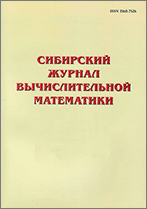|
An approximate solution of singular integral equations using the Chebyshev series on the class of functions vanishing at one end and turning into infinity at the other end of the integration interval
Sh. S. Khubezhty
K.L. Khetagurov North Ossetian State University, Vladikavkaz, Republic of North Ossetia-Alania, Russia
Abstract:
Computational schemes for an approximate solution of a singular integral equation of the first kind, bounded at one end and not bounded at the other end of the integration interval are constructed $[-1,1]$.
The solution of the equation is sought for in the form of a series in the Chebyshev polynomials of the third and the fourth kinds. The kernel and the right-hand side of the equation decompose into series with the use of the Chebyshev polynomials of the third and the fourth kinds, whose coefficients are approximately calculated by the Gaussian quadrature formulas, i.e. the highest algebraic degree of accuracy. For the coefficients of the expansion of the Chebyshev polynomials, exact values in the series are found. The coefficients of the expansion of the unknown function, i.e. solutions of the equation, are found from the solution to systems of linear algebraic equations.
To justify the constructed computing schemes, the methods of functional analysis and the theory of orthogonal polynomials are used. When the existence condition for the given functions of the derivatives up to some order belonging to the Holder class is satisfied, the calculation error is estimated and the order of its turning into zero is given.
Key words:
singular integrals, equation index, quadrature formulas, computational schemes, best uniform approximation, error estimation.
Received: 05.02.2018
Revised: 14.07.2020
Accepted: 14.04.2021
Citation:
Sh. S. Khubezhty, “An approximate solution of singular integral equations using the Chebyshev series on the class of functions vanishing at one end and turning into infinity at the other end of the integration interval”, Sib. Zh. Vychisl. Mat., 24:3 (2021), 331–341; Num. Anal. Appl., 14:3 (2021), 287–296
Linking options:
https://www.mathnet.ru/eng/sjvm784 https://www.mathnet.ru/eng/sjvm/v24/i3/p331
|

| Statistics & downloads: |
| Abstract page: | 237 | | Full-text PDF : | 38 | | References: | 40 | | First page: | 12 |
|




 Contact us:
Contact us: Terms of Use
Terms of Use
 Registration to the website
Registration to the website Logotypes
Logotypes








 Citation in format
Citation in format 